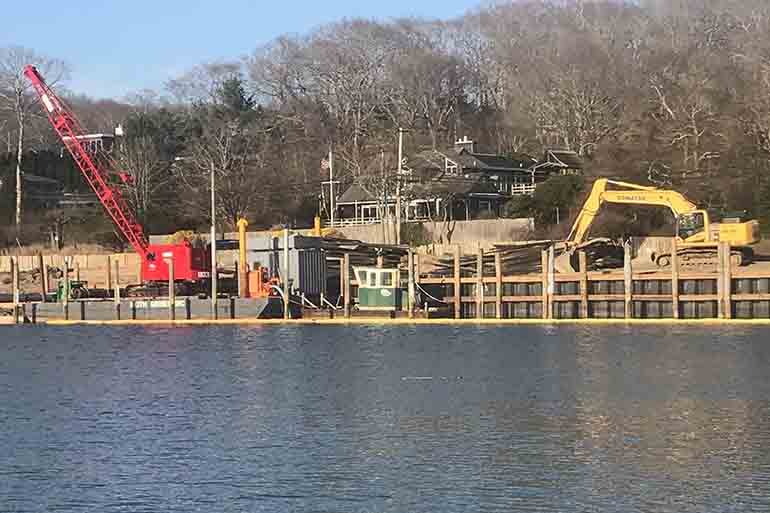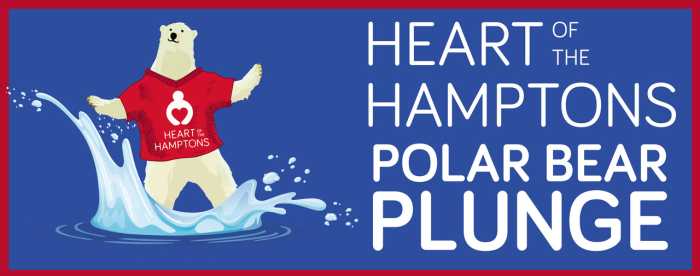A New Waterfront Park

Across the street from where I live, 30 boats bob side-by-side every summer in the slips of Town Marina. It’s a town-owned waterfront facility, 800 feet long and fifty feet wide. Mariners pay a fee to park their boats here. They’ve been doing it for years.
Every December, when no boats are in the slips, the overhead lights at night illuminate a row of colorfully lit Christmas trees placed by the Highway Department at intervals along the path and grass that separates the slips from the road. For the holiday season, it cheers up the dreariness of the winter. We see it from our living room.
This past December, however, there were no Christmas trees. I wondered why. I called the town. They said the trees would be back next year. But not this. No further explanation.
A few days later, construction workers arrived and provided the answer to that question. They put up a snow fence along the road for the entire length of this property. And the next day, two bulldozers appeared, whose drivers commenced noisily to dig up the path and grass and make the entire strip behind the bulkhead into a construction site. When I saw that, I strolled across the street, leaned on the snow fence and hailed the driver of the larger of the bulldozers. He stopped, turned the engine off, and hopped down—a handsome man of about 50 in a hard hat.
“I live across the street,” I said, introducing myself and pointing to one of the five homes facing the water on the other side of the road. “What are you doing?” I asked.
“We’re tearing out the old bulkhead, putting in a new one, taller and stronger. And I know who you are. You know my dad.”
He pointed to the side of his bulldozer. The driver’s door said KEITH GRIMES, with a phone number.
“Vinnie?” I asked.
“The same.”
“I used to sell advertising to Vinnie. He owned a gas station in Montauk for many years.”
“Yes, he did. He’s retired now.”
“Time flies. Please give him my regards.”
“I will.”
“So how long will this construction take?”
“We’re contracted to finish the project in time for the 2020 boating season. Should wind up the week after this coming Memorial Day.”
And with that, he got back in his bulldozer, started it up, waved and, with a roar, began shoving more dirt around.
A week later, steam shovels joined the bulldozer, making ever-louder banging noises in that narrow strip as they loaded the old dirt into trucks to have it carried away. Thus, a great gash was created behind the old bulkhead for its entire length. In February, a crane with a 40-foot boom arrived and workmen, operating at Keith’s orders, wrapped its chain around the old pilings and rusty steel and one after another pulled them up, dropped them into trucks and had them hauled away.
Also at that time, a 50-foot-tall pile driver secured to a barge was floated over and, as the old bulkhead was ripped away, workmen operating it repeatedly began dropping a heavy iron weight onto the top of newly arrived telephone poles, driving them into the seabed so other workmen could attach new steel to them. The huge racket all this heavy equipment made for the rest of the winter and early spring woke us up promptly at 8 a.m. every weekday morning. It became our alarm clock. By the way, every piece of equipment said KEITH GRIMES on the side.
Two days a week, we’d wake up at 8 a.m. because there was NO racket.
“Saturday,” my wife would roll over and tell me.
But on those weekdays, I’d see something, dress and walk over to hail Keith Grimes. Always, he’d stop, hop down from his bulldozer and patiently come over.
“What is it?” he’d ask.
“What’s going to happen with all these overhead lights?” I asked him one day.
They were atop telephone poles.
“We can only work around them for so long,” he said. “I’ve now got permission to take them down. But I’ll put them back.”
Another time, I asked him about grading. The road was higher than the bulkhead. In prior years, the grassy area between street and bulkhead was a hillside. Now, with the new bulkhead taller and further out into the water, this hillside would be less of a slope. Still, a ball thrown could roll into the water. Unless he was careful.
“I’m on it,” Keith said.
I was over other days, making other pointers and suggestions. In other words, I was now supervising. Keith patiently listened to what I had to say each time.
In late March, huge eight-ton reenforced concrete caissons as big as cars arrived on the backs of flatbed trucks. The workmen, using the backhoes and the crane, wrestled them down into the ditch behind the new bulkhead to reinforce it against future hurricanes and rising tides. After that, sand and topsoil came in, a magnificent boardwalk was built, and grass was planted between the boardwalk and the road.
Now there was now hardly any hill at all.
Keith Grimes got this finished on the second week of June, after the Memorial Day weekend. Working six months, he missed that deadline by five days. But I think they forgave him. And now the boats came in to tie up.
Today, the bulkhead is two feet higher and two feet further into the harbor for its entire 800-foot length. And what used to be a narrow path along the bulkhead is now a park with a wide boardwalk with benches and lawns.
It’s beautiful. Besides the boating people, couples with their children walk along the boardwalk. Lovers and older folk sit at the benches. Runners jog up and down its entire length. And people picnic there as the sun sets across the water.
Last week, during Labor Day weekend, we sat out on our patio with some friends (observing social distancing) and talked, among other things, about what is happening to America. There was the usual talk from some about liberals who want to tax the rich to help the poor, which would, some said, cripple businesses and make the citizenry lazy and not wanting to work anymore.
But one friend talked about the money used to create our new park across the street. The money had been raised by a recently created 2.5% tax on all real estate transactions exceeding a quarter of a million dollars. The rich were paying these taxes. So far, the tax has raised an astonishing billion dollars since its creation 15 years ago. And by law it’s used to buy property to become parks, historic museums and open space. It’s been a gift from the rich to the poor, if you look at it that way, but it’s actually a gift to everybody, rich and poor.
Here, just in the Springs where I live, the money has been used to create a farm museum on Cedar Street, a four-acre restoration of the home and studio of artist Jack Little on Squaw Road, a workshop and museum on North Main Street where, in the 18th century, members of the Dominy family made and sold grandfather clocks, a sandy and now-protected small island for picknickers in Three Mile Harbor and various nature preserves. Everyone loves the East End. So instead of it becoming all gated private mansions with Keep Out signs, this town and the other towns in the Hamptons have spent all this money to create new amenities for us all, on this stunning peninsula that is among the most beautiful in the world.
I have this wonderful memory of this project.
One day, shortly after 4 when everybody left the construction, I thought of some new thing I wanted to tell Keith Grimes. So, for the first time, I called his office.
“Is Keith there?” I asked.
“No, he isn’t. But he’ll be in in the morning.”
I knew him well enough by now. “Could you give me his cellphone?”
“He doesn’t have a cellphone.”
“Then tell me his email. I want to tell him something that can’t keep until morning.”
“He doesn’t use a computer,” I was told.
And so it occurred to me. He is in his bulldozer making the dirt fly wherever the jobs take him. He never grew up. He just likes smoothing and shifting the dirt in his bulldozer all day. And so that’s what he does.
He’s the Lone Ranger. He makes things right, then rides off into the sunset on his bulldozer to find a new place to work, leaving a silver bullet behind. Bravo, Keith!









